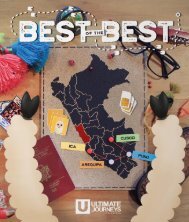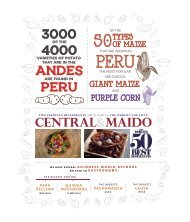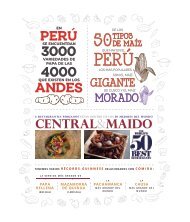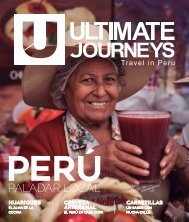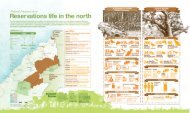UJ #17 - Traditional Peru
Create successful ePaper yourself
Turn your PDF publications into a flip-book with our unique Google optimized e-Paper software.
Lima is a perfect mix<br />
of past and present.<br />
Pictured, the Huaca<br />
Pucllana.<br />
LimaTours<br />
it from pirate attacks were torn down, and Lima began to<br />
expand. The neighbourhoods of Miraflores, Barranco, and<br />
Chorrillos were established, quickly becoming favourites<br />
amongst well-to-do Limeños, and mansions, wide avenues,<br />
trains, and trollies appeared as the city started to take a<br />
new, exciting shape. Today, modern areas continue to<br />
coexist with pre-Hispanic architecture – like the Huaca<br />
Pucllana – and parks full of history, like the Olivar.<br />
Besides the incredible aesthetic transformation Lima<br />
has undergone, the city’s essence has also changed<br />
considerably. Since the 1940’s, Lima was synonymous<br />
with progress for many of those living in the rural parts<br />
of <strong>Peru</strong>. Around this time, people began to migrate to<br />
the capital in search of economic opportunities, better<br />
education and healthcare. Over the years, millions of<br />
people have emigrated, bringing with them not only their<br />
physical baggage, but also, their substantial and important<br />
cultural loads.<br />
The result? An eccentric, diverse, and multicultural city.<br />
Lima’s gorgeous marinera dance now coexists with the<br />
traditionally Andean huayno; street signs have become<br />
bright and colourful – emblems of the urban chicha<br />
culture; ceviche is as recognized as quinua; it is not<br />
uncommon to hear cumbia on the radio, nor is it odd to<br />
hear Quechua spoken in the streets. All these things that<br />
once seemed so distant from the capital have become a<br />
part of it, enhancing the culture and adding more flavour<br />
into the local melting pot.<br />
LimaTours<br />
Lima is the only<br />
coastal capital in<br />
South America.<br />
Colour and tradition<br />
fill the city’s artisanal<br />
markets.<br />
For all these reasons, Lima’s anniversary is celebrated<br />
many different ways: with prayer, songs, dances, and<br />
fireworks that light up the sky. Big and small, we come<br />
together to celebrate our city: the historic, the modern,<br />
and the future Lima. A city that – while at times may<br />
seem noisy and chaotic – we are proud to call home.<br />
LIMEÑOS HAVE THEIR OWN<br />
DIALECT: ESPAÑOL RIBEREÑO, OR<br />
COASTAL SPANISH. INFLUENCED BY<br />
CASTILIAN SPANISH, THIS DIALECT<br />
IS CHARACTERIZED BY ITS LACK<br />
OF STRONG INTONATIONS. IT IS<br />
CURRENTLY SPOKEN THROUGHOUT<br />
THE COAST OF PERU.<br />
13




